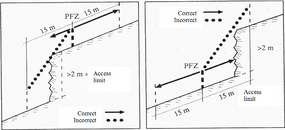Measuring slope
| (6 intermediate revisions by 3 users not shown) | |||
| Line 1: | Line 1: | ||
| − | {{ | + | {{Ficontent}} |
| − | + | [[File:2.5-fig21.png|left|285px|thumb|'''Figure 1''' Uneven oblique plane as used in Field Manual 2nd Swiss NFI (Brändli ''et al'' 1994<ref name="Brändli1994">Brändli UB, A Herold, H Stierlin und J Zinggeler. 1994. Schweizerisches Landesforst-inventar. Anleitung für die Feldaufnahmen der Erhebung 1993-1995. Birmensdorf, Eidg. Forschungsanstalt für Wald, Schnee und Landschaft. 204 S</ref>).]] | |
Slopes in [[forest inventory]] are more frequently measured in % than in degrees. Percent slope is determined by the ratio of ''rise'' over ''run''; i.e. a 10% slope implies a vertical change of 10 units ''rise'' over a distance of 100 units ''run''. For calculations, for example of [[The trigonometric principle|trigonometric]] functions, this must be converted to degree or radian with the arctangent function. | Slopes in [[forest inventory]] are more frequently measured in % than in degrees. Percent slope is determined by the ratio of ''rise'' over ''run''; i.e. a 10% slope implies a vertical change of 10 units ''rise'' over a distance of 100 units ''run''. For calculations, for example of [[The trigonometric principle|trigonometric]] functions, this must be converted to degree or radian with the arctangent function. | ||
| − | Slope angle is measured either with electronic [[:Category:Measurement devices|devices]] or | + | Slope angle is measured either with electronic [[:Category:Measurement devices|devices]], like e.g. [[Vertex]] or, with mechanical devices like [[Suunto]], [[relascope]], [[Blume-Leiss]], [[Clinomaster]] or others [[:Category:clinometer|clinometer]]. Slope measurement takes place parallel to the terrain inclination. This is straightforward if it is an oblique plain. If the terrain is irregular around the point where the slope angle needs to be measured, then clear rules need to be defined. An example from the Swiss national forest inventory is given in Figure 1. |
| − | + | ||
| − | + | ||
| − | + | ||
| − | + | ||
| − | + | ||
| − | + | ||
| − | + | ||
| − | + | ||
| − | + | ||
| − | + | ||
| − | + | ||
| − | + | ||
| − | + | ||
| − | + | ||
| − | + | ||
| − | + | ||
| − | + | ||
| − | + | ||
Latest revision as of 13:10, 27 October 2013

Slopes in forest inventory are more frequently measured in % than in degrees. Percent slope is determined by the ratio of rise over run; i.e. a 10% slope implies a vertical change of 10 units rise over a distance of 100 units run. For calculations, for example of trigonometric functions, this must be converted to degree or radian with the arctangent function.
Slope angle is measured either with electronic devices, like e.g. Vertex or, with mechanical devices like Suunto, relascope, Blume-Leiss, Clinomaster or others clinometer. Slope measurement takes place parallel to the terrain inclination. This is straightforward if it is an oblique plain. If the terrain is irregular around the point where the slope angle needs to be measured, then clear rules need to be defined. An example from the Swiss national forest inventory is given in Figure 1.
[edit] References
- ↑ Brändli UB, A Herold, H Stierlin und J Zinggeler. 1994. Schweizerisches Landesforst-inventar. Anleitung für die Feldaufnahmen der Erhebung 1993-1995. Birmensdorf, Eidg. Forschungsanstalt für Wald, Schnee und Landschaft. 204 S